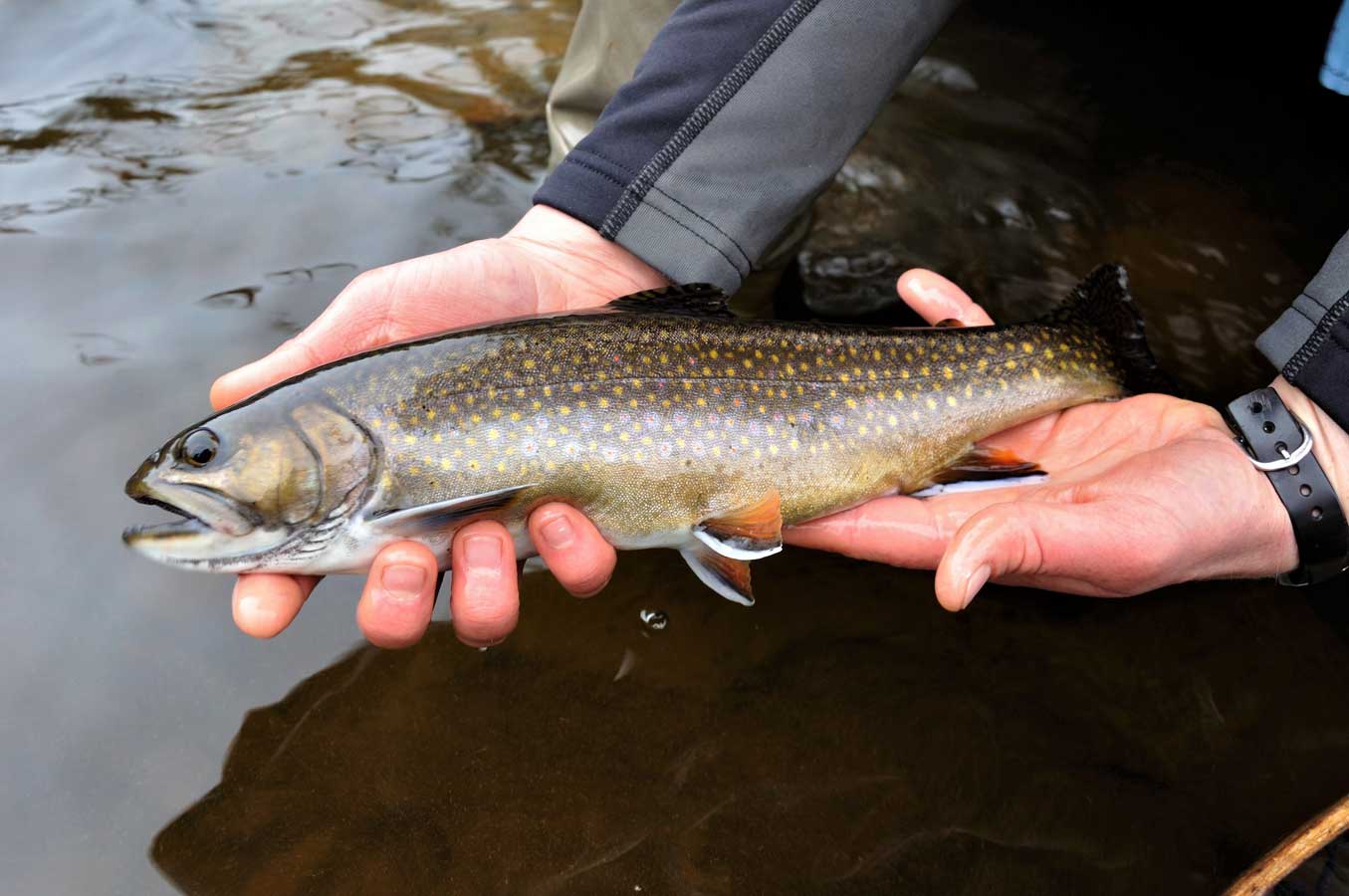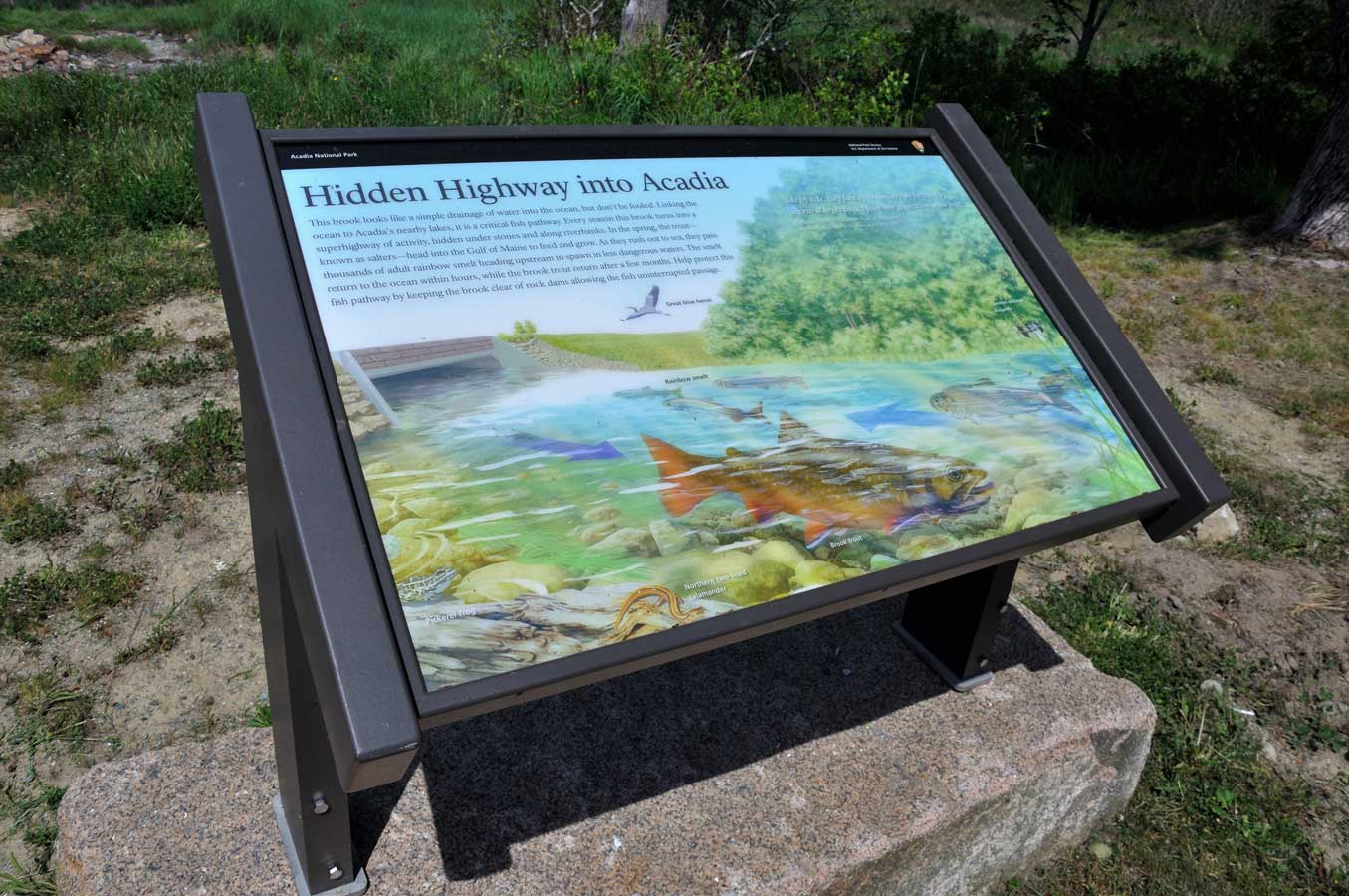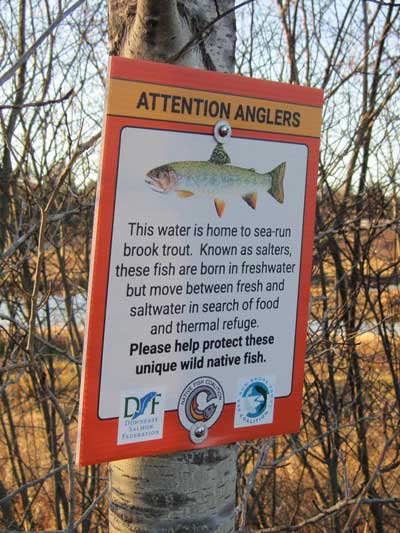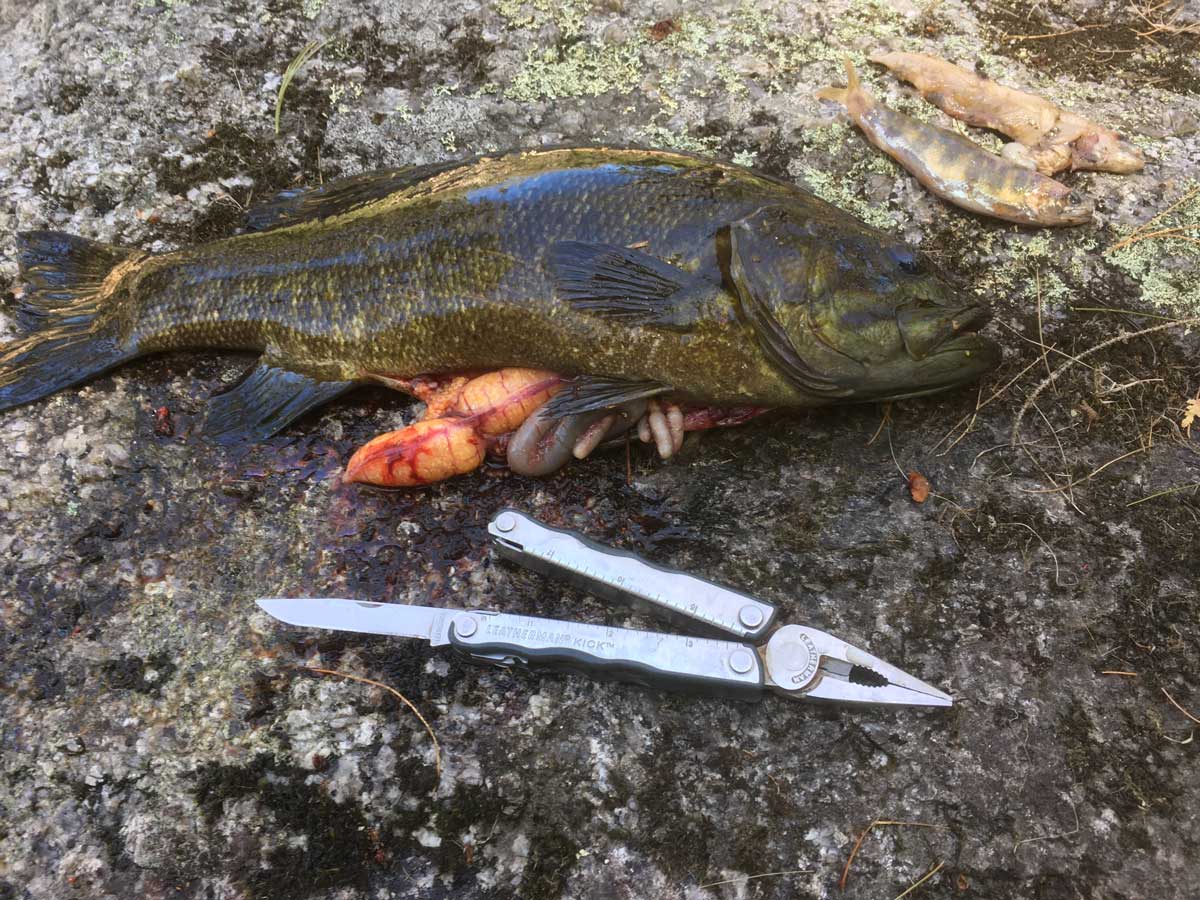Daniel Webster’s Trout: Preserving and Restoring the Nation’s Fabled Sea-Run Brook Trout

A sea-run brook trout from the Downeast region of Maine | Bob Mallard
Editor’s Note: This is the sixth article in our series on fly fishing conservation. This series appears with the support of Swift Fly Fishing, makers of Epic Fly Rods.
Imagine trout rubbing fins, figuratively speaking, with striped bass. Now imagine them doing so where whitetail deer graze within yards of basking harbor seals, and loons dive within feet of perched eagles. Add to this schools of rainbow smelt, river herring, and American shad, as well as mysterious American eels born in the Sargasso Sea, and critically endangered Atlantic salmon. This is the unique and fascinating world of sea-run brook trout.
Sea-run brook trout, or “salters” as they are called, are native to the northern Eastern Seaboard and Canada. Once found in coastal streams from the Canadian border to Long Island Sound, salter populations in the United States have been greatly reduced due to dams, development, agriculture such as cranberry and blueberry farming, pollution, nonnative fish introductions, state-sponsored stocking, and angler exploitation. Today, most wild native sea-run brook trout left in the United States are found on Cape Cod and the coast of Maine.
“Salters are a fascinating life form of brook trout that epitomize the adaptability of the species, a fish most of us know as a small, headwater stream resident. Most would never expect to find wild native brook trout along the densely populated Northeast coast, let alone brook trout that move between fresh and saltwater.” – Emily Bastian, National Vice Chair – Native Fish Coalition
America’s First Gamefish
Long before anglers discovered Montana, or even Maine, sea-run brook trout were a popular gamefish. At one time, the largest trout caught in America came from Long Island in New York and Cape Cod in Massachusetts. These fish were salters. Statesman Daniel Webster’s fabled 14 pound brook trout, a salter, came from the Carmans River in Long Island, then known as the East Connecticut River. Other sea-run brook trout waters included the Connetquot River in Long Island, and Red Brook and Quashnet River in Cape Cod.
The best way to describe sea-run brook trout is diadromous, or a fish that migrates between freshwater and saltwater. While sometimes referred to as anadromous like Atlantic salmon, smelt, herring, and shad, which are saltwater species that spawn and are reared in freshwater, they are not. And while there may be some exceptions, they are not catadromous, or freshwater fish that spawn in saltwater, like American eels. Sea-run brook trout live, spawn, and are reared in freshwater, but move into brackish and saltwater to feed and seek thermal refuge, or when the water in their natal streams becomes too low.
Once thought to be a sub-species of brook trout, while salters demonstrate a unique life history strategy, they are genetically the same as other brook trout. Their pale coloration, which likely contributed to the belief they were genetically different, is temporary, and the result of being in saltwater. Once salters have been in freshwater for a bit, days not weeks, their color returns and they look like any other brook trout. And while they eat primarily minnows, crustaceans, and sea worms while in saltwater, they revert to insect feeding once they return to freshwater.
What Is a Sea-Run Brook Trout?
While hotly debated, it is quite possible that what makes a brook trout sea-run or not is a combination of opportunity and personality. I say this because there appears to be no unique genetic marker, and not all fish from a given stream with access to the ocean seem to take advantage of it. In this way, they are very much like coasters, a potamodromous form of brook trout that move between rivers and streams and the Great Lakes. Like salters, coasters were once thought to be a subspecies.
Some sea-run brook trout winter in brackish or saltwater. While freshwater salmonids stop growing in the winter, sea-run brook trout that remain in saltwater continue to grow on an abundant supply of minnows and crustaceans. One study I read found that fish that wintered in saltwater grew 30 percent faster than those that remained in freshwater. Salters are also stronger, and fight better, than inland brook trout.
Once measured in pounds, not inches, salters were exceptionally large for brook trout and matched only by the coasters of the Great Lakes and fish caught in remote Labrador and Quebec. Today a 14” sea-run brook trout is considered large, and most run much smaller than that. What has caused the decline in salter size is unclear, but it could be due to genetic changes caused by generations of taking the top off the population via minimum length limit management.
“All coastal watersheds without barriers to fish-passage are, or have the potential to be, sea-run brook trout systems, which is a reflection of the species’ capacity to utilize all of the ecological niches available to it when allowed to do so.” – Dwayne Shaw, Executive Director – Downeast Salmon Federation
Unique Habitat
Coastal rivers and streams are unique, and in many ways. Their ending is abrupt, and disrupted, as they are lost in brackish water or saltwater rather than merging gently into a freshwater tributary. Some of these streams, or creeks as they are sometimes called in the southern extreme of their range, empty into salt marshes, others into estuaries, while some empty into open ocean, or crashing surf. One salter stream I know of goes intermittent before reaching the ocean in all but the highest tides.
Coastal rivers and streams have unique species assemblages. While home to all the flora and fauna found in similar freshwater environments, they are host to anadromous and catadromous fish only found where travel between freshwater and saltwater is possible. And many coastal rivers and streams have sections that while brackish in higher tides are freshwater in lower tides. This allows non-sea-run freshwater fish to temporarily occupy areas that are otherwise not conducive to them.
We don’t know nearly enough about sea-run brook trout. In some cases, it’s like they don’t even exist, and it’s clear they are not a priority to some of the state agencies tasked with protecting them. While Massachusetts, home to Red Brook, the most studied sea-run brook trout stream in the country, has done a lot to understand their salters, sea-run brook trout are one of the least-studied fish in Maine, at least by the state-level agencies charged with their well-being.
“Little is known about salters or where they still abide because, with the exception of Massachusetts, no state has paid serious attention to their management.” – Ted Williams, National Chair – Native Fish Coalition
Massachusetts Salters
Massachusetts Division of Fisheries and Wildlife pulled out all the stops in regard to restoring and preserving the salters of Red Brook and the Quashnet River, including imposing artificial lures and flies tackle restrictions and catch-and-release. Many other salter streams are managed under a reduced 3-fish limit. Unfortunately, the sea-run brook trout of the Santuit River, said to have held the largest salters in the state at one time, have disappeared, lost to a combination of events, including water drawdowns, and ill-advised tree removal to aid river herring passage.
To be clear, while Massachusetts has fared better than neighboring Connecticut, Rhode Island, and New Hampshire, the state has lost much of its historic sea-run brook trout populations. Once found from the New Hampshire border south to the Rhode Island border, and to the tip of Cape Cod, wild brook trout have been extirpated from many Massachusetts’ coastal waters.
“While using eDNA to sample coastal streams from the New Hampshire border to Gloucester, Massachusetts, we found most large streams including the Merrimac, Ipswich, Rowley and Parker Rivers to be completely devoid of brook trout.” – Geoffrey Day, Executive Director – Sea Run Brook Trout Coalition
While wild sea-run brook trout can be found in several streams in Massachusetts, all of which are in the Cape Cod area, and a few remnant populations may exist elsewhere in the southern extent of their range, they have been all but extirpated from New York, Connecticut, Rhode Island, and New Hampshire. But like other forms of brook trout, salters persist in Maine, as much by accident as design, which is home to 90% or more of the sea-run brook trout found in America today. As they say: As Maine goes, so goes salters….
Maine Salters (Inland Waters)
Sea-run brook trout in Maine’s inland waters fall under the jurisdiction of Department of Inland Fisheries and Wildlife (IFW). Most salter rivers and streams in Maine are managed under General Law regulations, the lowest level of protection allowed under law. This includes bait, which comes with a 30% incidental mortality rate, a 5-fish daily limit, and a 6” minimum length limit. Conversely, nonnative brown trout in coastal waters are protected under a 2-fish limit.
For years, IFW has stocked nonnative brown trout in coastal rivers and streams in Midcoastal and Southern Maine. While down to less than a half a dozen active programs, at one time there were close to fifty. Brown trout stocking in the Downeast region is mostly limited to lakes and ponds. But these fish can find their way into rivers and streams that are home to salters. Brown trout compete with native brook trout for food and space, can disrupt spawning, and may prey on juvenile brook trout. And stocked fish can introduce diseases, parasites, and viruses.
In 2014, Maine Audubon and Trout Unlimited, with help from Sea Run Brook Trout Coalition (SRBTC) and Downeast Salmon Federation (DSF), undertook a “citizen science” survey project to identify wild brook trout populations in coastal rivers and streams. The data collected was provided to IFW to help prioritize formal surveys to determine the presence of sea-run brook trout and direct management decisions. More than six years later no changes of any note have been made in regard to salter management.
When asked recently if sea-run brook trout were included in the new draft Brook Trout Management Plan, IFW said they were not. Conversely, lake and pond, and inland river and stream brook trout are included. Several years ago, I obtained a list of confirmed and reported salter streams from IFW. Stanley Brook in Acadia National Park, the most studied sea-run brook trout stream in Maine and home to a large streamside kiosk put up by the National Park Service which denotes the presence of sea-run brook trout, was not listed.
Recently, the Maine chapter of Native Fish Coalition (NFC) and DSF approached IFW in regard to partnering on a unique-in-the-nation study to determine if sea-run brook trout in a multi-stream bay environment demonstrate inter-stream movement. IFW declined to participate, stating it was a local not state issue. The study is taking place in the Downeast region, home to 90% of the state’s, and by default most of the nation’s, salters.
In 2020, while IFW was the sponsoring agency, a requirement of the program, they voted against a Maine Outdoor Heritage Fund grant application to help fund the project, saying it was “not a priority.” IFW did however vote to fund the creation of a stocked trout pond at the headquarters of an influential sporting organization.
Interestingly IFW lists, and incorrectly, “Anadromous Brook Trout” as a state-level Species of Special Concern on their website. Last updated in 2015, while Maine’s Wildlife Action Plan barely mentions sea-run brook trout, it does say that “Research” associated with “Diadromous Fish” is a “High” priority and specifically notes their desire to “Improve understanding of species distribution especially in regards to ecosystem interactions….” Isn’t that exactly what the DSF/NFC study aims to do?

A streamside kiosk on Stanley Brook in Acadia National Park | Bob Mallard
Maine Salters (Coastal Waters)
Sea-run brook trout in Maine’s coastal waters, up to the head-of-tide, fall under the jurisdiction of Department of Marine Resources (DMR). Up until a couple of years ago, DMR did not acknowledge the presence of sea-run brook trout in their literature or website yet recognized nonnative, and primarily stocked, brown trout. Not only were salters missing from a critically important Recreational Sportfishing Regulations hand-out, but they were also omitted under the Do You Know Your Catch? section on their website, home to species profiles, including nonnative brown trout.
While DMR jurisdiction covers an area where anglers are less likely to encounter or target sea-run brook trout, there are exceptions. And this is changing as more anglers learn about these unique and hard-fighting brook trout and venture further from traditional freshwater habitat.

DMR has however been willing to make concessions, including working with NFC and its partners to revise the Recreational Sportfishing Regulations sheet, now called Recreational Fishing Regulations, to include native brook trout and de-emphasize nonnative brown trout. DMR also worked with NFC to create a species profile for brook trout. And they recently agreed to partner with DSF, NFC, and others on the important inter-stream movement study.

Inter-Agency Turf Wars
The sea-run brook trout of Acadia National Park in Maine are unique by even salter standards. As the salters of Cape Cod are returning to Red Brook due to warming water in Buttermilk Bay, the fish in Acadia are dropping down to the ocean due to warming, and low, streams. Like sea-run brook trout elsewhere in Maine, Acadia’s fish are managed under General Law rules.
In 2016, I approached the National Park Service (NPS) regarding why they were failing to provide the wild native sea-run brook trout of Acadia with the same level of protection afforded wild native trout in other National Parks such as Yellowstone and Shenandoah. Below is a summary of what they told me, and the entire letter is posted on the NFC website:
“Since 1995, the park has met with and expressed concern about fisheries management to [Maine Department of Inland Fisheries and Wildlife.] During this twenty year period, NPS drafted several different draft Memoranda of Agreements for consideration by the agencies to articulate a plan for mutual management of fisheries and other resources in the mid-coast area of Maine. While none of these draft versions were signed, the NPS believes that a signed Cooperative Agreement would clarify the respective management and regulatory authorities, goals and objectives, and the roles and responsibilities of the NPS and the State of Maine in conducting this collaborative fisheries conservation program. While the NPS and IFW have many areas of mutual interest in protecting fisheries resources, a constructive management framework remains to be agreed to and put into operation.”
Management by Anonymity?
NFC has worked to inform and educate anglers, and others, in regard to sea-run brook trout. They believe an informed public is more likely to support initiatives to protect these fish. As part of a project co-sponsored by DSF and SRBTC, informational signs were posted along salter streams in Downeast Maine.
Looking to expand the salter sign project into Midcoastal and Southern Maine, NFC approached Maine Council of Trout Unlimited (TU) for support. After several meetings, TU declined to participate, citing concerns about drawing attention to these waters, and a lack of interest on the part of IFW. The problem with “management by anonymity” is that it only works as long as these waters remain anonymous, which in today’s social-media-obsessed world usually isn’t very long.
Fortunately NFC and SRBTC stayed the course and with the support, and co-sponsorship, of DMR informational signs were developed for the Midcoastal and Southern Maine region and started to go up in the summer of 2020. Without the support of IFW, however, the signs will be limited to coastal zones that fall under the jurisdiction of DMR.

An informational salter sign in Downeast Maine | Bob Mallard
Sea-run brook trout face an uphill battle. Many coastal streams are subject to drawdowns by municipalities, agriculture, and businesses. Others see chemical run-off from roads and farms. And as they are found near, or at sea-level, they could be negatively impacted by warming water, as well as warming ocean temperatures, resulting from climate change. Coastal real estate is in big demand, so development is always a looming threat. And like many wild native fish, salters have not escaped the scourge of nonnative fish.
In Maine, nonnative and highly invasive smallmouth bass, as well as largemouth bass, have found their way into many sea-run brook trout rivers and streams. This includes the critically important Downeast region, which is also home to federally endangered Atlantic salmon. Having seen firsthand what nonnative bass infestations have done to the upper Kennebec River system, as well as the fabled Rapid River, the prognosis is not good.

A nonnative bass with two juvenile brook trout it had eaten | Downeast Salmon Federation
While preserving sea-run brook trout will not be easy, and restoring them even more difficult, there is hope. Groups like Sea Run Brook Trout Coalition in Massachusetts, Downeast Salmon Federation in Maine, and Native Fish Coalition with chapters in Maine, New Hampshire, Massachusetts, and Connecticut are stepping up. They are working to preserve and restore salter habitat, support population studies, trying to gain protective regulations, and educating the public in regard to salters and the threats they face.
If we can’t protect Daniel Webster’s trout, and America’s first gamefish, what can we protect? The recreational angling community and media have embraced sea-run brook trout. They are a very hot fish right now. It’s time for the agencies responsible for the preservation of these fascinating fish to follow suit and provide the level of protection salters deserve and, in fact, need.
This article appears with the support of Swift Fly Fishing, makers of Epic Fly Rods.










